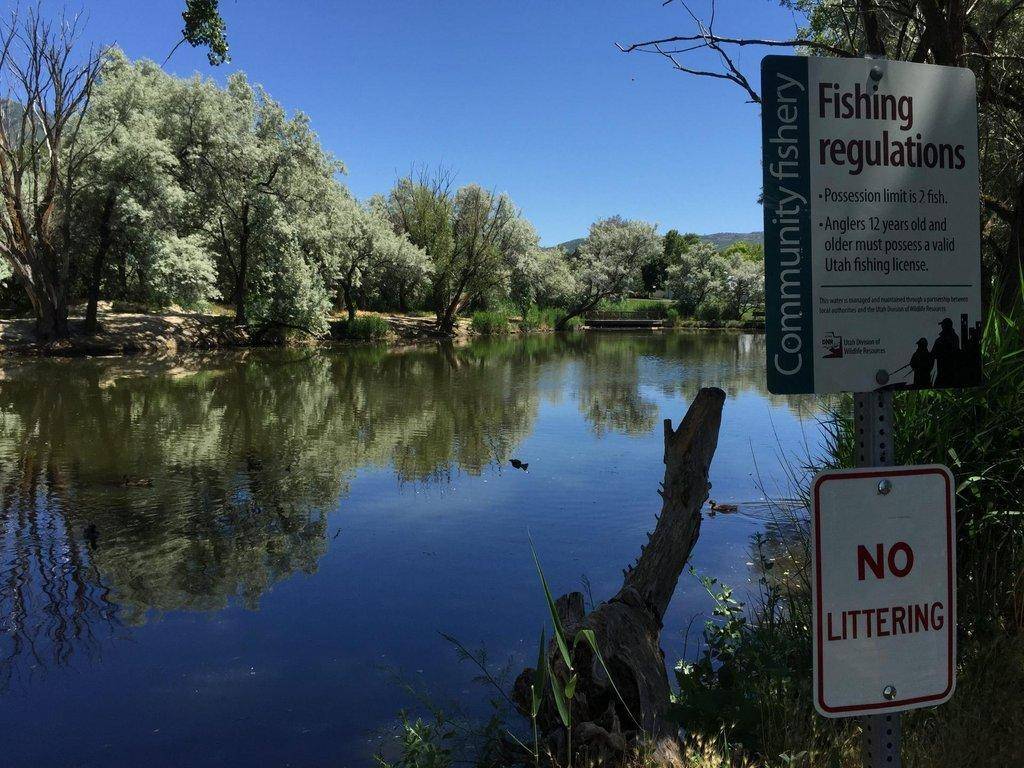DWR News Release
Thousands of urban residents across Utah currently have fishing opportunities within a few minutes’ drive — or even within walking distance from their homes — but it wasn’t always that way. The Utah Division of Wildlife Resources launched the community fisheries program 20 years ago, providing more fishing access and opportunities for many cities across the Beehive State.
When the community fisheries program launched in 2001, there were roughly 11 community fishing ponds across Utah. Now, with 57 ponds that are stocked annually with fish and dozens of thriving fishing clubs and angler education programs in the communities, Utah has one of the largest community fisheries programs in the U.S.
“We launched the program in an effort to provide more fishing opportunities for kids as well as those adults who can’t make it to the larger, more distant fisheries,” DWR Aquatic Section Chief Drew Cushing said. “Utah has become a lot more urban as the population along the Wasatch Front has expanded, and we wanted to make sure any kid in Utah had an opportunity to go out and engage in the sport of fishing close to home, regardless of if they live in the middle of a large city or in a small, rural community. The goal of the program and community fishing ponds was to provide them with an introduction to the outdoors and recreating in nature. But, this program isn’t just for youth — we also wanted to provide a place close to home for retired people who can’t drive as far anymore to enjoy fishing.”
Some of the community ponds were already in place, and DWR personnel worked with city officials to renovate the ponds and add additional amenities like docks and restrooms. Other community ponds were constructed in parks, utilizing water from springs, underground water sources and sometimes using water rights from irrigation systems.
“We have seen some pretty remarkable things since we formally launched this program and built new fishing ponds in some of these communities,” Cushing said. “In one city, they saw a high crime rate at the park at night. So, they partnered with us and built this community fishing pond in the park, and the crime rate dropped. In their opinion, it was due to people caring about and taking ownership of the community pond. I’ve been able to help build a number of the ponds in these communities, and I was always so happy to do that because I knew the benefit it was to the residents. Helping run the community fisheries program and teaching kids and community members how to fish was the best job I ever had.”
Brigham City was one of the first cities involved in the community fisheries program. With two community ponds — Mayor’s Pond and Rees Pioneer Park Pond — their program has grown over the years to include structured classes, special angling events and other activities that introduce residents to fishing. They also helped train other cities interested in the community fisheries program.
“Our community ponds provide amazing fishing access and are such a benefit for our residents,” Kristy Wolford, Brigham City Director of Community Activities and Services, said. “I see people using these ponds every single day. Recently, I was driving through town and drove past two 10-year-old boys walking with their fishing rods and tackle boxes toward the pond, and it just brought a smile to my face because isn’t that what it’s all about? To provide an opportunity for this next generation to enjoy Utah’s amazing outdoors. We have really enjoyed working with DWR in this program from the beginning and helping to implement it in other communities as well.”
DWR personnel stock the community ponds bi-weekly during the spring and fall months, using rainbow trout that are raised in local hatcheries. Channel catfish are trucked from Arkansas and stocked into the ponds several times during the summer. And, some of the community ponds are also stocked once per year with wipers, a sterile hybrid of a white bass and a striped bass. Some of the wipers are raised in local hatcheries and others are relocated from Arkansas.
“Our community fishing ponds are quite popular now,” DWR Northern Region Aquatics Manager Chris Penne said. “Last fall, we completed a survey at just six community fisheries in northern Utah, and in just two months, the ponds saw a combined 47,000 hours of fishing time. We are so glad that Utahns are using these ponds and enjoying fishing so close to home.”
While the DWR manages the fishing and stocks the ponds, the communities oversee the angler education programs and youth fishing clubs. There are currently 34 community fishing clubs, which are open to youth eight years old and older. Anyone 11 and under is not required to have a fishing license in Utah. The clubs generally meet once per week for six weeks. The DWR has provided the communities with an angler education curriculum designed to teach all of the basic skills needed to be a successful angler.
Many of the youth fishing clubs are run by volunteers, and anyone interested in helping with the programs can reach out to their city officials (contacts are listed on the DWR website). Volunteers are still needed for the following community programs:
- Wasatch Mountain State Park (Midway)
- Park City
- Pleasant Grove
- Sandy City
- Santaquin
- Saratoga Springs
- Springville

